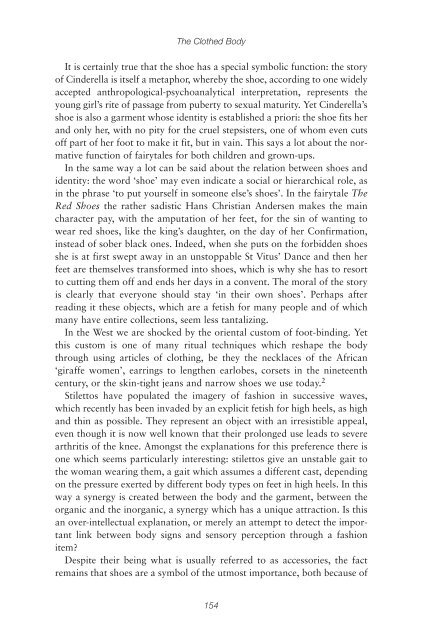Create successful ePaper yourself
Turn your PDF publications into a flip-book with our unique Google optimized e-Paper software.
<strong>The</strong> <strong>Clothed</strong> <strong>Body</strong><br />
It is certainly true that the shoe has a special symbolic function: the story<br />
of Cinderella is itself a metaphor, whereby the shoe, according to one widely<br />
accepted anthropological-psychoanalytical interpretation, represents the<br />
young girl’s rite of passage from puberty to sexual maturity. Yet Cinderella’s<br />
shoe is also a garment whose identity is established a priori: the shoe fits her<br />
and only her, with no pity for the cruel stepsisters, one of whom even cuts<br />
off part of her foot to make it fit, but in vain. This says a lot about the normative<br />
function of fairytales for both children and grown-ups.<br />
In the same way a lot can be said about the relation between shoes and<br />
identity: the word ‘shoe’ may even indicate a social or hierarchical role, as<br />
in the phrase ‘to put yourself in someone else’s shoes’. In the fairytale <strong>The</strong><br />
Red Shoes the rather sadistic Hans Christian Andersen makes the main<br />
character pay, with the amputation of her feet, for the sin of wanting to<br />
wear red shoes, like the king’s daughter, on the day of her Confirmation,<br />
instead of sober black ones. Indeed, when she puts on the forbidden shoes<br />
she is at first swept away in an unstoppable St Vitus’ Dance and then her<br />
feet are themselves transformed into shoes, which is why she has to resort<br />
to cutting them off and ends her days in a convent. <strong>The</strong> moral of the story<br />
is clearly that everyone should stay ‘in their own shoes’. Perhaps after<br />
reading it these objects, which are a fetish for many people and of which<br />
many have entire collections, seem less tantalizing.<br />
In the West we are shocked by the oriental custom of foot-binding. Yet<br />
this custom is one of many ritual techniques which reshape the body<br />
through using articles of clothing, be they the necklaces of the African<br />
‘giraffe women’, earrings to lengthen earlobes, corsets in the nineteenth<br />
century, or the skin-tight jeans and narrow shoes we use today. 2<br />
Stilettos have populated the imagery of fashion in successive waves,<br />
which recently has been invaded by an explicit fetish for high heels, as high<br />
and thin as possible. <strong>The</strong>y represent an object with an irresistible appeal,<br />
even though it is now well known that their prolonged use leads to severe<br />
arthritis of the knee. Amongst the explanations for this preference there is<br />
one which seems particularly interesting: stilettos give an unstable gait to<br />
the woman wearing them, a gait which assumes a different cast, depending<br />
on the pressure exerted by different body types on feet in high heels. In this<br />
way a synergy is created between the body and the garment, between the<br />
organic and the inorganic, a synergy which has a unique attraction. Is this<br />
an over-intellectual explanation, or merely an attempt to detect the important<br />
link between body signs and sensory perception through a fashion<br />
item?<br />
Despite their being what is usually referred to as accessories, the fact<br />
remains that shoes are a symbol of the utmost importance, both because of<br />
154

















